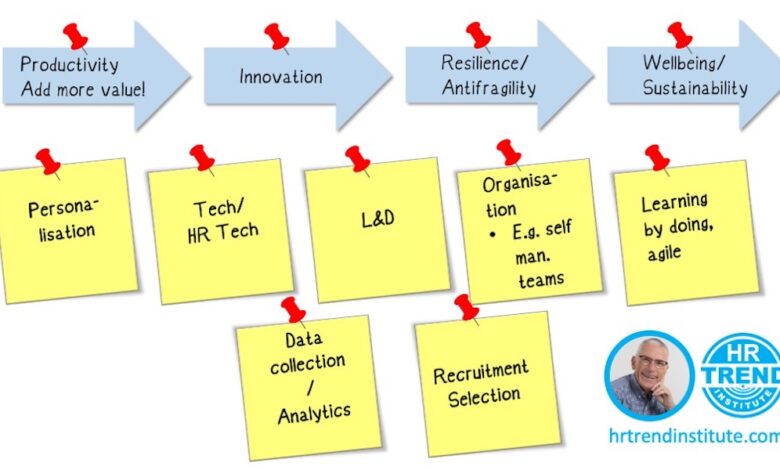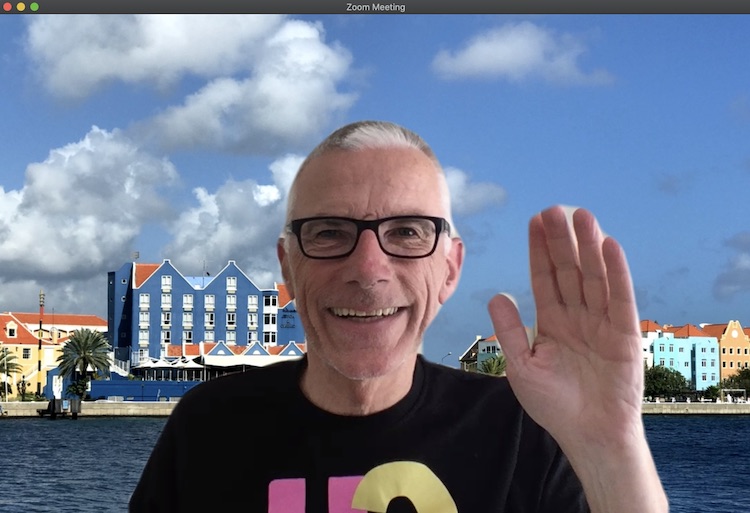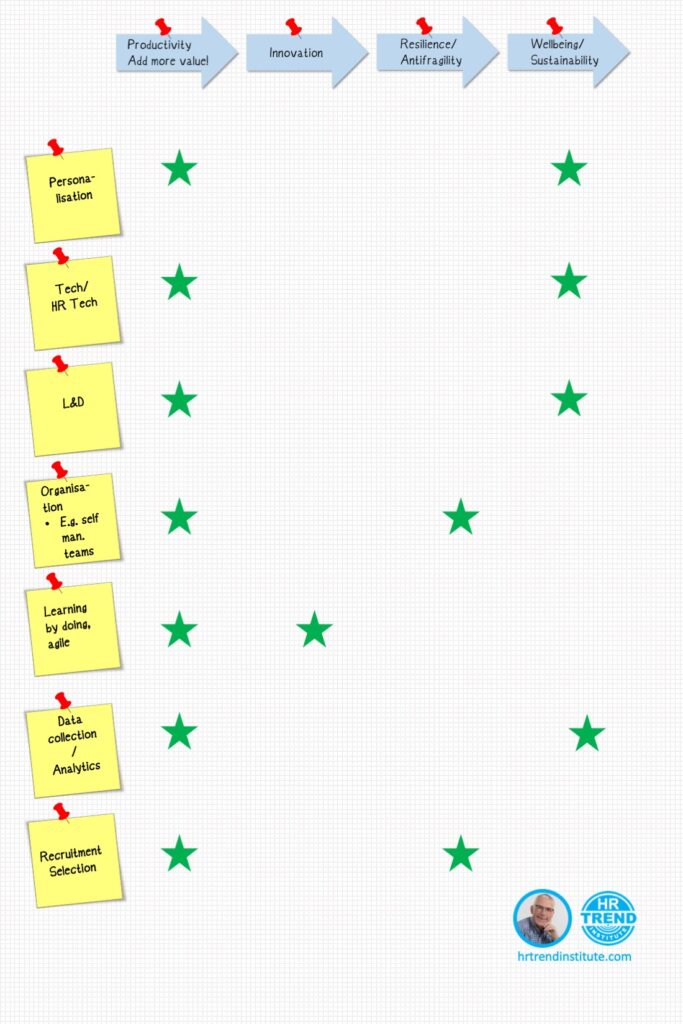
Important business themes
Generalising is dangerous. Organisations and businesses face all kind of different challenges. We expect some of them to be rather common. The most important priority for HR: what can we contribute to dealing with the most burning challenges.
1. Productivity and growth
Productivity: “The quality, state, or fact of being able to generate, create, enhance, or bring forth goods and services” (Dictionary.com)
Some people don’t like the term productivity. It sounds too tayloristic. And it doesn’t have an inherent growth component. We could talk about “adding more value”, or “getting back on track”. Many business have suffered. The productivity of most people and teams have probably declined, although I also hear stories about teams that are performing better, as they have to travel less, get less attention from the bosses and have to spend less time in unproductive meetings. In most cases, the question “how do we get back on track” or even more urgent “how do we survive the coming months”, is high on the list.
2. Innovation
“Innovation in its modern meaning is “a new idea, creative thoughts, new imaginations in form of device or method”. Innovation is often also viewed as the application of better solutions that meet new requirements, unarticulated needs, or existing market needs” (Wikipedia)
The question “how do we get back on track?” can probably not be answered by “by returning to the things we always did, and now with double effort, as we have to make up for the lost months”. The markets have changes. The circumstances are different. The clients are cautious. The regulations are tougher. The pressure of society has increased. Getting back on track requires innovations. In most sectors innovations were required anyway, but the Corona crisis has increased the pressure.


An example: the HR conference business
An example in an industry I am part of: the conference business, specifically the HR conference business. It is remarkable, but every year there were many many big (and small) HR conferences. A competitive but not very innovative business. Most conferences are organised with the same ingredients: a nice location, some big sponsors, speakers from well known companies and some HR gurus, an HR innovation award, a party and something funny and entertaining.
This industry is now disrupted. Big conferences are not longer possible, and it is highly unlikely they will be possible in the coming years. Innovation is required, but not so easy. Some producers continue to organise the conferences, but now online. I have participated in a few the last weeks, but the initial results are not very promising. Still many of the same boring powerpoint presentations. The only advantage is that it is easy to slip out of the room.
But you can also see the first sighs of small innovations. Moving from conference organiser to content creator and learning platform curator. Last week I was in a conference where the live conference was free, but if you want to review the videos or get access to the slides, you have to become a member for a monthly fee. I have also seen more voting and some subgroup sessions. Early days, and big room for some real innovations and breakthroughs.
Have a look at the “No more Boring Webinars” webinar of Cyriel Kortleven. He certainly has some good ideas.
3. Building resilience
Resilience: “The ability to be happy, successful, etc. again after something difficult or bad has happened” (Cambridge dictionary)
“Antifragility is a property of systems that increase in capability to thrive as a result of stressors, shocks, volatility, noise, mistakes, faults, attacks, or failures. It is a concept developed by Professor Nassim Nicholas Taleb in his book, Antifragile” (Wikipedia)
Building resilience is high on the priority list of many. This time we might have been caught off guard, but this won’t happen to us again. How can we make sure our organisations is better resistant to new disruptions? Or even better, how can be benefit better a next time? What kind of people do we need to become a more resilient organisation? What are elements of “resilient personalities”?
4. Wellbeing
“Wellbeing is the experience of health, happiness, and prosperity. It includes having good mental health, high life satisfaction, a sense of meaning or purpose, and ability to manage stress” (Psychology Today)
Wellbeing. In this list on the fourth place. Maybe it should be higher, but for wellbeing is is very important that organisations survive, innovate and grow. Work is an important driver of wellbeing. Wellbeing should be viewed a broad concept. It is about physical and mental wellbeing. It is about the wellbeing of all people the workforce, candidates, suppliers, the families of the people in the workforce and also the people in the wider society. In the Netherlands these weeks we have seen some examples of organisations that apply a far too limited definition of wellbeing: we are only concerned with the wellbeing of our employees when they are at work (not when they travel to work, not when they live in shabby conditions because our pay is so poor).
Read: HR – Health & Safety first
HR interventions
So, the question for HR: what can we contribute to dealing with these most burning challenges? In the figure below, I tried to outline the possible impact of nine HR intervention areas. I forced myself to pick maximum two stars per row. This is work in progress, and of course I am interested to hear your views. Ample opportunities to impact productivity and wellbeing, somewhat less for innovation and resilience. About each of the boxes in the grid below a lot can be said, I will just scratch te surface in this article.

Personalisation
“The process of making something suitable for the needs of a particular person” (Cambridge Dictionary)
Personalisation is “a means of meeting the customer’s needs more effectively and efficiently, making interactions faster and easier and, consequently, increasing customer satisfaction and the likelihood of repeat visits,” according to TechTarget. It’s achieved when a system tailors an experience based on a consumer’s previous behaviors. For example, Amazon personalizes its home page for each user based on that user’s previous searches, views and purchases. (-) Personalisation is achieved through customer data and predictive technology. (Towerd@ta).
The initial reaction in crisis situations is to forget personalisation and move back to one-size-fits-all. After the initial shock, the realisation comes that a personalised approach can be a lot more effective. The definition above speak about “customer needs”. Customer can be replaced with candidate, employer, whatever is appropriate. It is not only about needs, but also about capabilities, preferences and personality.
Remote working is a good example. Saying: “Everybody has to work from home, unless your job does not allow this”, which was the message in many countries during the initial phases of the COVID-19 crisis, does not necessarily work well. Some people do not have a good work environment at home (small apartment, children, demanding partner etc), for others is does not fit well with their personality, as they are generally stimulated an inspired by the people around them. Or they are just starting in a new job, and need clear instructions during onboarding. By using data to analyse and predict the needs of people in the workforce, we can take more focused and diverse measures. More about personalisation in this video and in some of the articles in the reading list.
“HR technology (human resources technology) is an umbrella term for software and associated hardware for automating the human resources function in organisations. It includes employee payroll and compensation, talent acquisition and management, workforce analytics, performance management, and benefits administration.” (TechTarget)
The times for HR tech will be good. The (HR) digital transformation will be accelerated by the current crisis. The introduction of HR tech is not a goal in itself, but an essential part of the transformation. Not automating old practices, but redesigning practices, with the possibilities created by technology in mind. Example: just introducing video interviewing will not reduce the role of cognitive biases in the selection process.
Learning & Development
The gap between what is possible in Learning & Development and what is actually happening is still big. I refer to my article “18 trends for learning organisations” (see chart below) and the interview in the video for more background.

The way you are organised
Self Managed Team: “A self-organised, semiautonomous small group of employees whose members determine, plan, and manage their day-to-day activities and duties under reduced or no supervision. Also called self directed team or self-managed natural work team.” (Business Dictionary)
The way organisations are structured potentially have a big impact on the mentioned business themes. Self-managed teams will have a great advantage in turbulent times, as they are used top operate without having to wait for instructions from the top. I hope I will have time to expand this section at a later stage.
The way you work
“According to the HR Trend Institute, “Agile HR” refers to:
- a way of working and organising of the HR function that facilitates responsiveness and adaptiveness of activities and structures,
- facilitating the flexibility in matching workforce fluctuations to demand, and
- the way the HR function supports the organisation in becoming more responsive and adaptive.
With Agile HR, the traditional focus on control and alignment has shifted to a more Agile focus on speed of responsiveness and customers.” (GSA Tech Guides).
“Design thinking is a non-linear, iterative process which seeks to understand users, challenge assumptions, redefine problems and create innovative solutions to prototype and test. The method consists of 5 phases—Empathise, Define, Ideate, Prototype and Test and is most useful when you want to tackle problems that are ill-defined or unknown.” (Interaction Design Foundation)
For the moment I gladly refer to the following articles on our website:
- Sara Coene: How to start with design thinking in HR
- Tom Haak: 7 aspects of agile HR
People Analytics
“People analytics can be defined as the deeply data-driven and goal-focused method of studying all people processes, functions, challenges, and opportunities at work to elevate these systems and achieve sustainable business success.” (HR Technologist)
The most effective HR intervention, with the biggest short term impact, remains recruitment. Hiring new people leads to faster results than trying the change the existing population trough traditional learning and development efforts. A good starting point might be to review your profiles. Are you looking for “future proof” candidates? Is “personal resilience” one of the selection criteria? Will your new people be able to come with innovative ideas, and are they able to work fast and agile? Will they feel at home in a remote workforce?
More about recruitment and selection trends in the video.
Checklist
A simple checklist can help you to check if your new and existing initiatives are contributing to the burning issues. For this example checklist we have chosen the four priority areas on our list, but of course you can replace with others.
Questions
- What are the most important themes/ issues in your organisation? Are productivity, innovation, resilience and wellbeing on the list?
- What is your view on the possible impact of the HR interventions on productivity, innovation, resilience and wellbeing? Is your assessment different? Can you illustrate your thoughts with examples, or even better evidence?







